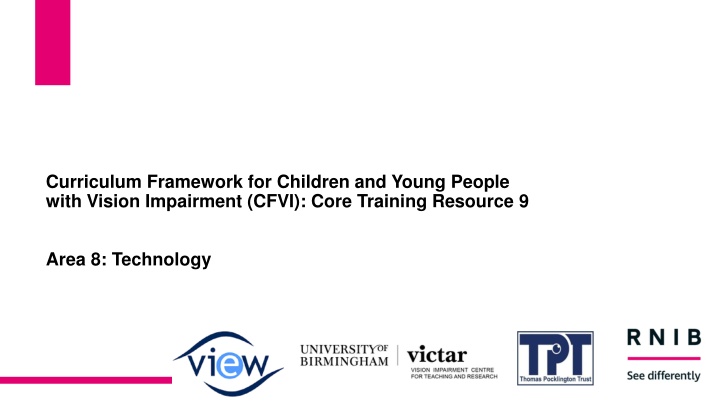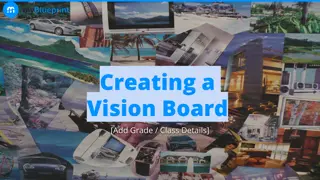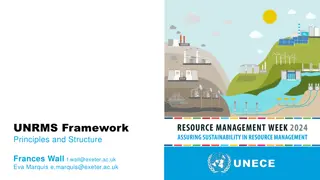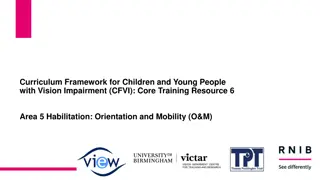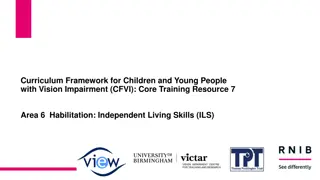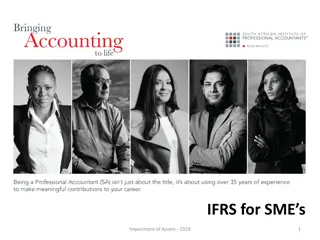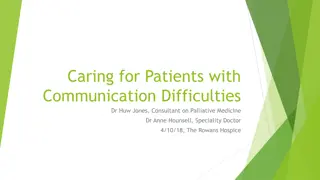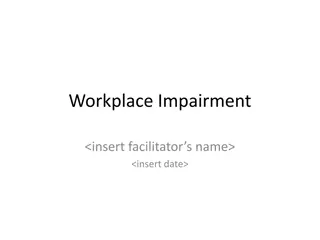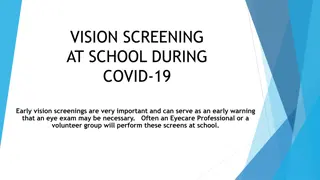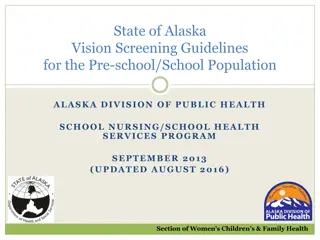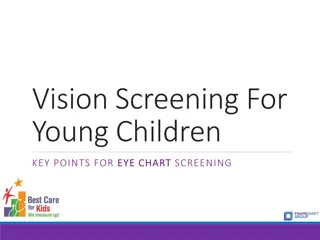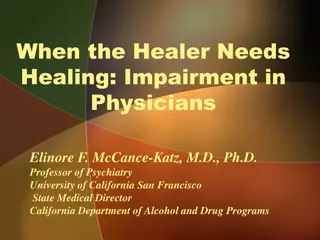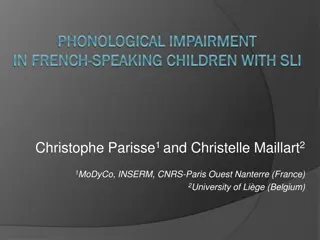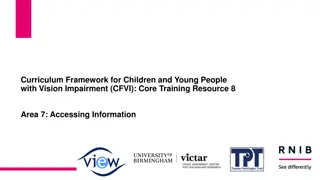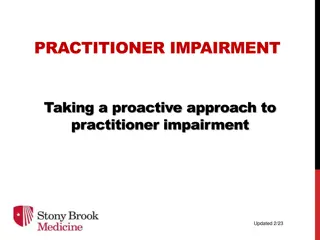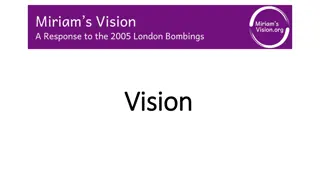Core Training Resource: Technology for Children with Vision Impairment
This core training resource focuses on Area 8: Technology within the Curriculum Framework for Children and Young People with Vision Impairment (CFVI). It highlights the importance of providing technology training to children with vision impairment, outlines various technologies for learning access, and addresses potential barriers. The resource also emphasizes early access to suitable technology to enhance independence.
Download Presentation

Please find below an Image/Link to download the presentation.
The content on the website is provided AS IS for your information and personal use only. It may not be sold, licensed, or shared on other websites without obtaining consent from the author.If you encounter any issues during the download, it is possible that the publisher has removed the file from their server.
You are allowed to download the files provided on this website for personal or commercial use, subject to the condition that they are used lawfully. All files are the property of their respective owners.
The content on the website is provided AS IS for your information and personal use only. It may not be sold, licensed, or shared on other websites without obtaining consent from the author.
E N D
Presentation Transcript
Curriculum Framework for Children and Young People with Vision Impairment (CFVI): Core Training Resource 9 Area 8: Technology
Project Partners There are 4 partner organisations involved in the CFVI project. The production of these training/continuing professional development materials was led by VIEW (The Professional Association for the Vision Impairment Education Workforce), in association with a consultation group of stakeholders working in the field of VI Education.
Curriculum Framework for Children and Young People with Vision Impairment (2022, p.15)
Training Objectives (1) The objectives of this training resource are to: Provide an introduction to Area 8 of the CFVI: Technology. Examine why a focus on this area is important for learners with vision impairment. Outline a range of technologies that might be used by CYPVI to access learning. Explore potential barriers that may limit access and use of different technologies and how we can work together to help reduce these. Provide links to useful resources/websites.
Training Objectives (2) Customisable slide if needed (see notes which give examples of training objectives that you could consider, depending on the nature of your presentation).
About this area: Technology (1) This area of the framework recognises the importance of children and young people with vision impairment being provided with the training and opportunity to be able to use technology and equipment with as much independence as possible. Some technologies require bespoke teaching and will need to be delivered by a professional with specialist knowledge of that technology. It is important that children and young people have access to the most appropriate technology for their needs at as early an age as is possible, and that this is facilitated within their day to day working.
Identifying potential barriers to access (1) Situation A primary age pupil without a vision impairment using a touch screen tablet in class to search the internet as part of class topic work. How does vision inform the pupil in this situation? information about the particular visual features of the tablet including size, colour, location of buttons etc location and meaning of icons what type of technology other students are using in the class where their peers are in relation to themselves what the key search terms and useful websites are through looking at the class whiteboard where the teacher is located ? Suggested key search terms and a list of useful websites are displayed on the class whiteboard.
Identifying potential barriers to access (2) Situation Inclusive strategies to reduce barriers to access ? ? ? A primary age pupil with reduced near and distance vision using a touch screen tablet in class to search the internet as part of class topic work. Suggested key search terms and a list of useful websites are displayed on the class whiteboard.
Identifying potential barriers to access (3) Situation Inclusive strategies to reduce barriers to access ? Add here
Why a focus on this area is important Children and young people with vision impairment will have reduced access to visual information which can limit their participation in education. Technology is key in providing access to learning and supporting the development of learning to access skills. When used effectively with clear educational purpose and is closely matched to individual access and support needs, technology can enable them to participate in many areas of education alongside their peers.
About this area: Technology (2) We need to recognise that some children and young people may have conditions which means they experience fatigue when using screens. Therefore, a balance of high-tech and low-tech solutions may be required. Where appropriate, it is also important that children and young people are empowered to be able to make informed choices about the most appropriate technology for them to use in different situations. Recognition should be given to the rapidly changing nature of this area due to technology advances. We need to provide opportunities for children and young people (and those advising and teaching them) to learn about the introduction of new technology and how it could potentially be of benefit.
Types of technology (1) Type of technology Design use Examples Designed for general use without specific consideration for the needs of people with disabilities. Sometimes also referred to as majority technologies. laptops, desktops, calculators, DVD players, radios, televisions etc. 1. Mainstream technologies Designed for general use but which can be customised by people with disabilities to meet their specific needs. With well- designed adaptions many majority technologies can be made more accessible. tablets, laptops, smartphones with various features that can enhance accessibility 2. Accessible technologies Specifically designed to enable people with different types of disabilities to perform tasks. Braillers (manual and electronic), optical and non-optical low vision aids, enlargement software, screen readers 3. Assistive technologies
Types of technology (2) Mainstream Technologies Many types of mainstream technologies such as radios, television, radio, calculators, interactive whiteboards can be used by CYPVI to access learning without the need for them to be individually adapted. The type of technology that is selected will depend on the nature and type of the disability e.g. a child with low vision may be able to make use of a standard large screen display calculator whereas a child who is blind will require a more specialist talking calculator. CYPVI may be able to participate in some activities with their peers and use the same types of majority technologies as children/young people without vision impairment to access learning (for example, radio, smart speaker etc)
Types of technology (3) Accessible Technologies Accessible technologies are designed to be used by the majority of people but they can be customised to make them more accessible for people with particular types of disabilities. These technologies offer opportunities for CYPVI to access learning in a wide range of settings. There are many different types of devices available including pcs, laptops, mobile phones and tablets which include features meaning they can easily be customised for people with different types of access needs arising from vision impairment. These features include: Immersive Reader in Word, voice over on iPad and iPhone, Windows narrator and magnifier, touch screen magnification on laptops etc.
Types of technology (4) Assistive Technologies Unlike majority and accessible technologies assistive technologies are specifically designed to enable CYPVI to perform tasks. There are very many assistive technologies available for people with vision impairment some of these are relatively high-tech such as electronic devices for children/young people with communication difficulties, whilst others are relatively low-tech such as a reading stand.
Examples of targeted intervention approaches for Area 8 listed in CFVI to reduce barriers (1) Use of interactive whiteboards, screen sharing apps and software. Magnification and screen reading software, braille displays and notetakers, touch monitors. Adaptations to accessible mainstream technology, e.g. tablets, accessibility tools and general / universal settings on standard operating systems, apps for mobile phones/tablets.
Examples of targeted intervention approaches for Area 8 listed in CFVI to reduce barriers (2) Technology and equipment for accessing the curriculum and beyond: e.g. switches, computers, accessible scientific calculators for non-visual learners, accessible music composition software programmes, tactile protractors. Technology for life: e.g. mobile phones, apps (including specialist apps such as colour recognition tools), GPS and navigation apps (including transportation apps), social media, speech input software. Access to E-learning, for example, virtual learning environments.
Examples of targeted intervention approaches for Area 8 listed in CFVI to reduce barriers (3) Touch typing, including keyboard shortcuts, navigation skills, scrolling, searching, tabbing through documents (e.g. headings, links). Understanding choice e.g. switches, computer programming. Keeping safe in a digital world.
Why a focus on this area is important for (name of child/young person); what interventions are in place? Details of pupil s vision impairment How it influences their access to the curriculum/social interactions What interventions are in place to promote the efficient use of technology? What are the envisaged outcomes? Who delivers/works on these outcomes?
Summing up Vision impairment creates distinctive barriers to access, learning and participation for children and young people. This includes identifying potential barriers to using technology in a given setting. Targeted intervention approaches within inclusive learning environments (See CFVI, Area 1) are required to promote effective use of technology. A wide range of devices can be used to enable CYPVI to access learning in education and with appropriate learning to access skills, develop increasing control of their learning. In considering the role of technology we need to be concerned not only with providing a child/young person with access to a particular device, but also with ensuring that the child is able to use it effectively and with increasing independence as they get older.
What resources are available The Bookshare Hub hosting resources to support the delivery of the CFVI is available from the RNIB (External). Of particular relevance to this area is the Technology category of the CFVI Resource Hub The CFVI provides a list of targeted intervention approaches (pages 28 and 29): Curriculum Framework for Children and Young People with Vision Impairment | RNIB
References Hewett, R., Douglas, G., McLinden, M., James, L., Brydon, G., Chattaway, T.,Cobb, R., Keil, S., Raisanen, S., Sutherland, C., Taylor, J., (2022) Curriculum Framework for Children and young People with Vision Impairment [CFVI]: Defining specialist skills development and best practice support to promote equity, inclusion and personal agency. RNIB
